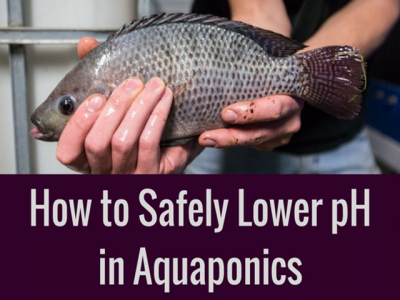How to Safely Lower pH in Aquaponics

Our advice to lower pH in aquaponics
High pH is a common concern among beginning and intermediate aquaponic growers, who want a quick fix to bring it down.
My philosophy on lowering the pH in a system with high pH is simple.
If you’re thinking about using a chemical or acid to lower your pH, don’t. You’re just going to make your life more costly and complicated than it needs to be.
High system pH is almost invariably caused by carbonate buildup in the system (when it’s not carbonates in the form of limestone grow bed media, concrete in the fish tank, etc.).
When it is carbonate buildup in the system, your pH is being “buffered,” or maintained artificially high by the carbonate cycle of your water.
Carbonates can be a complicated subject, so I’m not going too complicated here. The thing to remember is that carbonates have the ability to dissolve into solution and precipitate out of solution.
The way that they do this maintains pH in a very specific high range until one day, you’re adding an acid like you usually do, and your pH crashes. Bottoms out. Drops like a rock.
When this happens this quickly in high pH systems, the first thing that happens is nitrification stops- which we all know is a very bad thing.
How to Safely Lower pH
So what are you supposed to do?
If your water isn’t too hard (high carbonates), you can eventually get your nitrification to the point where your acidification from nitrification outstrips the carbonates entering your system, leading to a naturally low pH.
When done correctly and slowly, the nitrifying bacteria will adjust and there’s no shock. Once you reach this sweet spot in your system’s health and lifespan, it is a wonderful thing.
At this point you have control of your system pH. Where do you want it? It’s completely up to you.
The best way to keep pH from getting out of control is an RO filter
RO filter - use to lower pH in aquaponicsIf your water is harder, or if you simply don’t want to wait, the best thing to do is install an RO filter (Reverse Osmosis). RO filters remove almost everything from the water (including carbonates) leaving you with very pure, carbonate-free water.
RO filtered water is simple stuff.
You can allow nitrification to drive pH down, or you can add simple hydroxides to raise pH (and supplement nutrients) with no long term pH effects.
RO filters can cost a few hundred dollars, but in my experience, many of the folks who spend months struggling with pH, and artificially trying to lower it, reached the point where looking back, they wish they’d just installed an RO filter and avoided the cost and heartache of fighting the fundamental chemistry of their system.
Don’t forget about Biological Surface Area
So there it is. You have two solutions- either be patient or drop some money on an RO filter.
If you do choose to wait, I do recommend using a growing technique that contributes lots of Biological Surface Area to the system.
This increases the potential amount of nitrifying biomass in your system as well as the resulting efficiency in nitrification. This can lead to faster nitrification based carbonate consumption.
Arianna - ph in aquaponics
We use ZipGrow Towers for this purpose because our media has massive Specific Surface Area (SSA) and really helps get nitrification at peak efficiency.
I hope this is helpful for you and really commiserate with those of you who are struggling with this issue.
Controlling your system pH can be an incredibly frustrating task, but if you follow my advice, you can take the first steps towards taking control of your system and how it operates. Leave a comment if you need help!
Có thể bạn quan tâm
 The importance of digestibility enhancers in current aquafeed formulations
The importance of digestibility enhancers in current aquafeed formulations How adding lyso-phospholipids and bile salts to aquaculture feeds can improve the absorption efficiency of major nutrients, particularly lipids, by fish.
 Ich (White Spot Disease) - Part 1
Ich (White Spot Disease) - Part 1 Ich is a common name for the par- asite Ichthyophthirius multifiliis and the disease that it causes. The parasite is capable of killing large numbers of fish
 Ich (White Spot Disease) - Part 2
Ich (White Spot Disease) - Part 2 The shear numbers of Ich organisms covering the gills also causes a mechanical blockage of oxygen transfer.